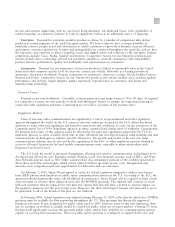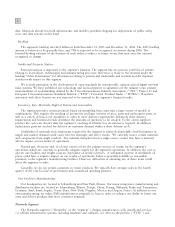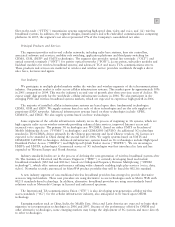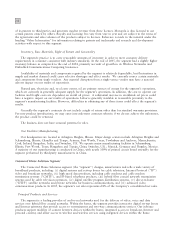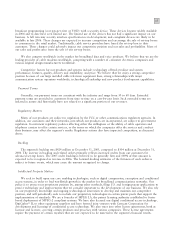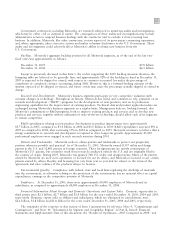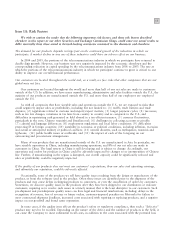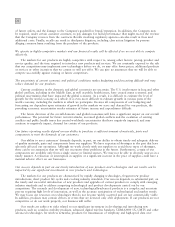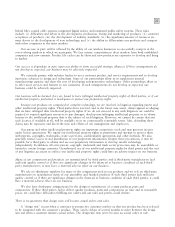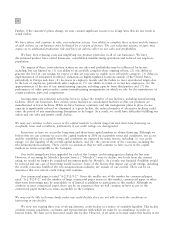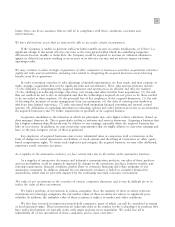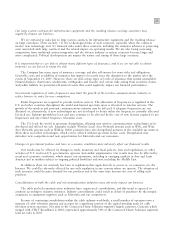Motorola 2005 Annual Report Download - page 23
Download and view the complete annual report
Please find page 23 of the 2005 Motorola annual report below. You can navigate through the pages in the report by either clicking on the pages listed below, or by using the keyword search tool below to find specific information within the annual report.
16
Inventory, Raw Materials, Right of Return and Seasonality
Substantially all of our products are manufactured at our facilities in Taipei, Taiwan and Nogales, Mexico.
Inventory levels are managed in line with existing business conditions.
Availability of materials and components required by the segment is relatively dependable, but fluctuations in
supply and market demand could cause selective shortages and affect results. We currently source certain materials
and components from single vendors. Any material disruption from a single-source vendor may have a material
adverse impact on our results of operations.
Electricity is the primary source of energy required for our manufacturing operations, which is currently in
generally adequate supply for the segments operations. In addition, the cost to operate our facilities and freight
costs are dependent on world oil prices. A substantial increase in world-wide oil prices could have a negative
impact on our results of operations. Labor is generally available in reasonable proximity to the segment's
manufacturing facilities. However, difficulties in obtaining any of the aforementioned terms could affect the
segments results.
Generally, we do not permit customers to return products. We have not experienced seasonal buying patterns
for our products recently. However, as our retail cable modem and digital set-top box sales increase, we may have
increased sales during the holiday season at the end of each year.
Our Facilities/Manufacturing
Our headquarters are located in Horsham, Pennsylvania. We also have research and development and
administrative offices in San Diego, San Jose and Sunnyvale, California; Lexington and Marlboro, Massachusetts;
and Lawrenceville, Georgia. We have several sales offices throughout North America, Europe, Latin America and
Asia, and we operate manufacturing facilities in Taipei, Taiwan and Nogales, Mexico. We also use contract
manufacturers with plants in China for a portion of our cable modem/voice module production in order to
enhance our ability to lower our costs and deliver products that meet consumer demand.
Other Information
2005 Change in Organizational Structure. Effective on January 1, 2005, the Company reorganized its
businesses and functions to align with the Company's seamless mobility strategy. The Company was organized into
four main business groups, focused on mobile devices, government and enterprise, networks and the connected
home. The Mobile Devices business is primarily comprised of the former Personal Communications segment and
the Energy Systems group from the former Integrated Electronic Systems segment (""IESS''). The Government and
Enterprise Mobility Solutions business is primarily comprised of the former Commercial, Government and Industrial
Solutions segment and the Automotive Communications and Electronics Systems group from the former IESS. The
Networks business is primarily comprised of the former Global Telecom Solutions segment, the Embedded
Computing and Communications group from the former IESS, and the next-generation wireline networks business
from the former Broadband Communications segment (""BCS''). The Connected Home Solutions business is
primarily comprised of the former BCS, excluding the next-generation wireline networks business. In addition, the
Company's key support functions, including supply-chain operations, information technology, finance, human
resources, legal, strategy and business development, marketing, quality and technology have been architected
centrally and distributed throughout the Company.
Financial Information About Segments. The response to this section of Item 1 incorporates by reference
Note 10, ""Information by Segment and Geographic Region,'' of Part II, Item 8: Financial Statements and
Supplementary Data of this document.
Customers. Motorola has several large customers, the loss of one or more of which could have a material
adverse effect on the Company. Motorola's largest end customers (including sales through distributors) are Sprint
Nextel, Cingular, China Mobile, Amπerica M πovil and T-Mobile. Motorola sold approximately 12% of its products
and services to Sprint Nextel in 2005.
Approximately 2% of Motorola's net sales in 2005 were to various branches and agencies, including the armed
services, of the U.S. Government. All contracts with the U.S. Government are subject to cancellation at the
convenience of the Government.



